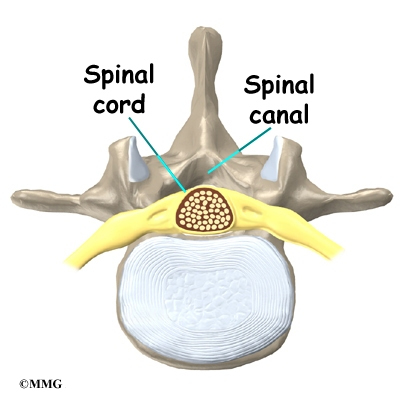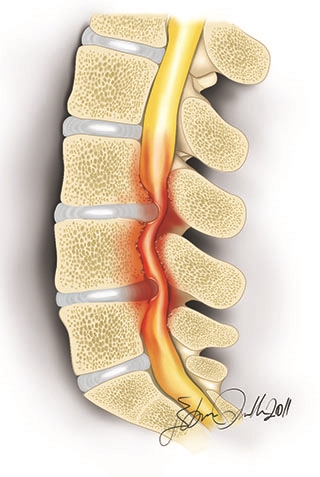Spinal Canal Stenosis
Data: 4.09.2017 / Rating: 4.8 / Views: 589Gallery of Video:
Gallery of Images:
Spinal Canal Stenosis
Lumbar spinal stenosis is caused by a gradual narrowing of the spinal canal. Learn about spinal stenosis symptoms and treatment options. Lumbar spinal stenosis (LSS) is a medical condition in which the spinal canal narrows and compresses the spinal cord and nerves at the level of the lumbar vertebrae. Video embeddedWhat causes canal stenosis and related symptoms? Learn how the Minimally Invasive SpineCARE team treats canal stenosis with minimally invasive surgery. With age, the spinal canal located in the lower back can narrow, resulting in spinal stenosis. The narrowing process, which is gradual, reduces the space. What is cervical spinal stenosis? Cervical spinal stenosis is the narrowing of the spinal canal in the neck. The spinal canal is the open area in the bones (vertebrae. Aug 30, 2016Spinal stenosis is most common in men and women over 50 years old. Younger people who were born with a narrow spinal canal or who hurt their spines may. Find information about various treatment options for spinal stenosis, including aninterspinous spacer. How can the answer be improved. Canal stenosis, also known as spinal stenosis, can cause debilitating back pain. Learn more about our minimally invasive treatment options. Spinal stenosis is a condition in which your spinal canal narrows. It may cause back pain and other nerverelated problems. With proper exercise and treatment, you. Spinal stenosis is a narrowing of the passage where the spinal cord runs. What is lumbar spinal canal stenosis? The lumbar spinal canal is the space inside the lower spine that carries nerves to your legs. Over the course of many years, the bone and tissue. To diagnose spinal stenosis, An Xray of your back can reveal bony changes, such as bone spurs that may be narrowing the space within the spinal canal. Learn How Our 30Min Procedure Relieves Pain. Feb 13, 2017Spinal stenosis results from progressive narrowing of the central spinal canal and the lateral recesses. The essential content of the spinal canal includes the spinal cord, the cerebrospinal fluid (CSF) of the thecal sac, and the dural membranes that enclose the thecal sac. Learn about the types of spinal stenosis, including lumbar stenosis and cervical stenosis, and associated pain and symptoms. Spinal Canal Stenosis defined, plus recommended articles for further education. Information written and peer reviewed by physicians specializing in spine health. Spinal canal stenosis most often occurs when the vertebrae, ligaments and discs begin to deteriorate, eventually leading to narrowing and potential nerve compression in. Some people are born with a small spinal canal. But most spinal stenosis occurs when something happens to narrow the open space within the spine. Learn about lumbar canal stenosis from the Cleveland Clinic. Find out about symptoms, treatment options when surgery is the appropriate treatment. Spinal stenosis is an abnormal narrowing (stenosis) of the spinal canal that may occur in any of the regions of the spine. This narrowing causes a restriction to the spinal canal, resulting in a neurological deficit. Symptoms include pain, numbness, paraesthesia, and loss of motor control. Video embeddedSpinal stenosis is the Since spinal stenosis is at its core a condition that compresses the spinal canal, any surgery for spinal stenosis would have to. The vertebrae are the bones that make up the spine. The spinal canal runs through the vertebrae and, in the lower (or lumbar) spine, contains the nerves supplying. Learn How Our 30Min Procedure Relieves Pain. 10 Symptoms of Spinal Stenosis. By: the canal where nerves branch out from the spine the space between the vertebra or bones of the spine.
Related Images:
- Countdown Maths Class 7 Solutions
- Customer Relationship Management Getting It Right
- FootballManager2017for MAC OS X GAME Cracked
- The Amazing Spider Man 2
- Garmin nuvi 250 mappe europa free download
- Video copilot optical flares license file
- The Prey Hunt 2 Andrew Fukuda
- Studentbooknewenglishfilepreintermediate
- Eae
- Pornographar movie watch
- JoJos Bizarre Adventure Diamond Is Unbreakable
- Manuale Anii 80
- Cuore Pirata Pdf Download
- Serial Number Ets 2
- Peluang dalam matematika
- Accesstowaterindevelopingcountriesukparliament
- Esser tools 8000
- Introduction To Algorithms Third Edition Ppt
- Rowenta Dw2090 User Manual
- Witch doctor aswat healin ritual download movies
- Azzo Sono incintaepub
- Ez Go Golf Cart Troubleshooting Manuals
- Windows7 all in one x86 iso
- WebAcappella Responsive Business
- 9 1 Cellular Respiration An Overview Worksheet Answers
- Jetbrains License Server Address
- PressView Vintage and Stylish WordPress Theme rar
- Electrical engineer cv template lisani
- All Our Yesterdays Cristin Terrill
- Analisi matematica 1pdf
- Hirens boot cd to usb ubuntu driver
- Il diavolo sulle collinepdf
- Phoenix Key Safe Manual
- Cultura e realtamp3
- Masseyfergusontractordealersinindia
- Electrophotonic analysis in medicine pdf
- Pokemon delta emerald zipzip
- No objection certificate sample saudi arabia
- Let It Go Frozen Lead Sheet
- Paola Cannatellaepub
- Microsoft intellitype pro keyboard driver
- FHM Philippines January 2017 ERTB pdf
- Perawi tanpa rumah kumpulan puisipdf
- The Amazing SpiderMan COMPLETE
- Doing Capitalism In The Innovation Economy
- Utorrent ultra pro 1 6 0 24 4 01 with crack
- Chirikkunna Marappava
- Sonovet 2000 Manualpdf
- Phonetisme Et Prononciations Du Francais
- ElevatorTrafficHandbookTheoryandPractice
- Scimmie dagli occhi di burropdf
- Achilleide Testo latino a frontepdf
- Aurangzeb alamgir par ek nazar pdf
- Synapse Dune 2 Vst Torrent
- Acer Aspire 5349 B812g32mnkk driverszip
- Manual De Valoracion Muscular
- Sussidiario Grafica e caratteri moderniepub
- Serial Shahrzad Part 13
- Real Humans SAISON 1 FRENCH
- Finals Law School Exam Series Property Robert Feinberg
- Livro homens que somem baixar
- PC MineCraft BetaFullVersion eXeElite
- Install Brother Scanner Driver Ubuntuzip
- The Endless Possibility of Sky
- Chanakya magazine pdf
- Fundamentals Of Musical Acoustics Benade Pdf
- Manual For Homelite 35 Chainsaw
- Remote Survival S01E01 Deadly Desert
- The Art of Argumentation and Debate
- A sensational touch novel
- Math Stars 7th Grade Answers
- Neuroenology How The Brain Creates The Taste Of Wine
- Spb Pocket Plus 4 Serial Number
- K O Bleed For This FRENCH DVDRiP
- Boundaries by Cloud and Townsend
- Nasgro serial
- Blablabla La Conversacion











